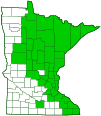Allegheny serviceberry
(Amelanchier laevis)
Conservation • Description • Habitat • Ecology • Use • Distribution • Taxonomy
Conservation Status |
|
|||||||
| IUCN Red List | LC - Least Concern |
|||||||
| NatureServe | NNR - Unranked SNR - Unranked |
|||||||
| Minnesota | not listed |
|||||||
Description |
||
Allegheny serviceberry is a large shrub or small tree. It occurs in eastern North America, where it is native, from Nova Scotia to Maryland, west to Ontario, Minnesota and Iowa, and south along the Appalachian Mountains to northern Georgia. It is also cultivated in Europe. It is found in upland, deciduous and mixed forests, in thickets, and on roadsides. It grows under full or partial sun in dry or moderately moist, sandy or sandy-loamy soil. When growing in woodlands, it is a small, single-stemmed, understory tree up to 50′ (15 m) in height and 7″ (18 cm) in diameter at breast height. When growing in thickets, it is a tall shrub with up to 20 upright stems. It does not spread by underground horizontal stems (rhizomes). The bark is thin, smooth, and ashy gray with dark, vertical lines when young. As it ages, it splits along the lines, developing long, dark, vertical furrows with smooth, flat ridges between them. On older bark, the flat ridges become rough and darkened, especially near the base. First year branchlets are slender, greenish, and hairless. Second year branchlets are brown to reddish-brown. Terminal buds are reddish-green to reddish-yellow, up to ½″ (13 mm) long, pointed, and covered with six visible scales. The second scale is less than half as long as the bud. When a leaf drops away, the scar that remains (leaf scar) has three raised areas (bundle scars). The leaves are alternate. They are on hairless, ⅜″ to 1″ (10 to 25 mm) long leaf stalks (petioles). Emerging leaves are hairless. They are distinctly coppery red and less than half unfolded at flowering time. Fully developed leaves are green, egg-shaped to elliptic or oblong, 1 9⁄16″ to 2¾″ (40 to 70 mm) long, and 1″ to 1 9⁄16″ (25 to 40 mm) wide. The leaf blades are rounded to slightly heart-shaped at the base and taper to a point at the tip with straight or concave sides along the tip. They are pinnately veined with 6 to 9 veins on each side. The veins join together (anastomose) before reaching the margin. The upper surface is dark green and hairless. The lower surface is pale green and hairless or almost hairless. The margins have 25 to 40 short, sharp, forward pointing teeth on each side, more than twice as many teeth as there are veins. The longest tooth is less than 1⁄32″ (1 mm) long. The basal (proximal) half has usually 5 to 12 teeth, sometimes up to 19 teeth, on each side. The last ⅜″ (1 cm) has usually 5 to 9 teeth, sometimes up to 13 teeth. The inflorescence is an unbranched, 1 9⁄16″ to 2¾″ (40 to 70 mm) long cluster (raceme) of 5 to 12 flowers at the end of the stems and branches. The flowers appear from mid-April to late May. Each flower is on a hairless flower stalk (pedicel). The lowermost pedicels are ⅝″ to 1″ (15 to 25 mm) long when in flower. One or two of the pedicels may be subtended by a leaf. The flowers are large, about 1″ in diameter, and showy. They have both male and female reproductive parts. There are 5 sepals, 5 petals, 20 stamens, and 5 styles. The sepals are green, triangular, and short, ⅛″ to 3 ⁄16″ (2.5 to 5 mm) long. They are erect when in flower, bent backward when in fruit. The petals are white, narrowly inversely egg-shaped to oblong-linear, ⅜″ to ⅝″ (10 to 16 mm) long, and ⅛″ to ¼″ (4 to 6 mm) wide. The ovary is hairless at the top. The fruits are globe-shaped, ¼″ to 5⁄16″ (6 to 8 mm) in diameter pomes with 4 to 10 seeds each. They are on 1″ to 1 9⁄16″ (25 to 40 mm) long pedicels. They are green at first, soon becoming red, then dark purple at maturity. They mature in early mid-July to late mid-August. |
||
Height |
||
6½′ to 50′ (2 to 15 m) |
||
Flower Color |
||
White |
||
Similar Species |
||
The species epithet laevis means “hairless”, and this is the feature that best distinguishes Allegheny serviceberry from downy serviceberry (Amelanchier arborea). |
||
Habitat |
||
Dry to moderately moist. Upland deciduous and mixed forests, thickets, and roadsides. Full or partial sun. Sandy or sandy-loamy soil. |
||
Ecology |
||
Flowering |
||
Mid-April to late May |
||
Pests and Diseases |
||
|
||
Use |
||
Allegheny serviceberry has good quality fruits with a sweet tart flavor. Ripe fruit can be eaten fresh or used in jams, jellies, and pies. |
||
Distribution |
||||
|
Sources |
|||
| 7/20/2023 | ||||
Nativity |
||||
Native |
||||
Occurrence |
||||
Occasional or infrequent. Fairly common in just a few east-central counties. |
||||
Taxonomy |
|||
| Kingdom | Plantae (Plants) | ||
| Division | Tracheophyta (Vascular Plants) | ||
| Subdivision | Spermatophytina (Seed Plants) | ||
| Class | Magnoliopsida (Dicots) | ||
Order |
Rosales (Roses, Elms, Figs, and Allies) | ||
Family |
Rosaceae (Rose) | ||
| Subfamily | Amygdaloideae | ||
| Tribe | Maleae | ||
| Subtribe | Malinae | ||
Genus |
Amelanchier (serviceberries) | ||
Subordinate Taxa |
|||
|
|||
Synonyms |
|||
Amelanchier arborea ssp. laevis Amelanchier arborea var. cordifolia Amelanchier arborea var. laevis Amelanchier laevis var. nitida |
|||
Common Names |
|||
Allegheny serviceberry smooth serviceberry smooth shadbush |
|||
Glossary
Anastomosing
Referring to veins, such as on a plant leaf or a lichen, or lines on an insect wing, that branch and rejoin, forming a network.
Bundle scar
Tiny raised area within a leaf scar, formed from the broken end of a vascular bundle.
Pedicel
On plants: the stalk of a single flower in a cluster of flowers. On insects: the second segment of the antennae. On Hymenoptera and Araneae: the narrow stalk connecting the thorax to the abdomen: the preferred term is petiole.
Petiole
On plants: The stalk of a leaf blade or a compound leaf that attaches it to the stem. On ants and wasps: The constricted first one or two segments of the rear part of the body.
Pinnately veined
With the veins arranged like the vanes of a feather; a single prominent midvein extending from the base to the tip and lateral veins originating from several points on each side.
Pome
A fruit with a central seed bearing core enclosed in thick flesh, e.g., an apple or pear.
Raceme
An unbranched, elongated inflorescence with stalked flowers. The flowers mature from the bottom up.
Rhizome
A horizontal, usually underground stem. It serves as a reproductive structure, producing roots below and shoots above at the nodes.
Sepal
An outer floral leaf, usually green but sometimes colored, at the base of a flower.
Visitor Photos |
|||||
Share your photo of this plant. |
|||||
| This button not working for you? Simply email us at info@MinnesotaSeasons.com. Attach one or more photos and, if you like, a caption. |
|||||
Luciearl |
|||||
I had several trees/shrubs that came down in heavy winter weather. Both of these bloomed and had fruit on them, although nearly knocked to the ground. |
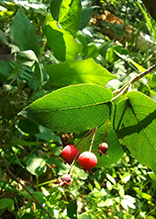 |
||||
MinnesotaSeasons.com Photos |
|||||
Plant |
|||||
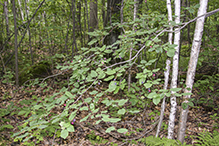 |
|||||
Leaves |
|||||
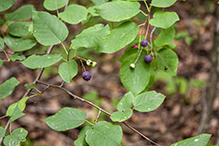 |
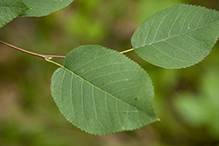 |
||||
Fruit |
|||||
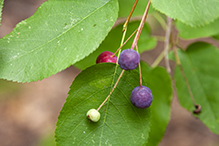 |
|||||

Slideshows |
||
| Amelanchier-laevis Lassi Kalleinen |
||
About
Feb 8, 2013 Amelanchier laevis blooming in the spring |
||
| Amelanchier laevis The Tree Library |
||
 |
||
About
Allegheny Serviceberry |
||

Visitor Videos |
|||
Share your video of this plant. |
|||
| This button not working for you? Simply email us at info@MinnesotaSeasons.com. Attach a video, a YouTube link, or a cloud storage link. |
|||
Other Videos |
|||
| Amelanchier laevis Allegheny Serviceberry QuipTV |
|||
About
Jun 15, 2012 Amelanchier laevis Zones 4-8 Plant in 4+ hours of sun (full sun to part sun) 20'-40' H x 15'-20' W Blooms: white fragrant flowers in spring. Fruits in mid-summer Water: Average water needs Uses: Flowering tree, street tree, Native, Naturalizing, Wetland Plant Attracts butterflies & birds. Easy to grow |
|||

Visitor Sightings |
|||||
Report a sighting of this plant. |
|||||
| This button not working for you? Simply email us at info@MinnesotaSeasons.com. Be sure to include a location. |
|||||
| Luciearl 7/9/2023 |
Location: Fairview Twp. I had several trees/shrubs that came down in heavy winter weather. Both of these bloomed and had fruit on them, although nearly knocked to the ground. |
||||
MinnesotaSeasons.com Sightings |
|||||

Created: 7/20/2023
Last Updated:
